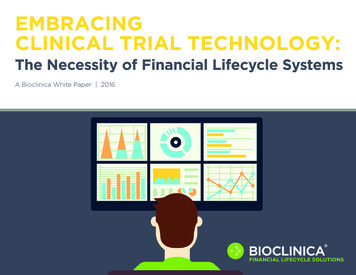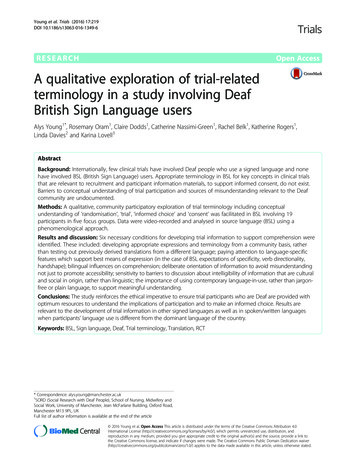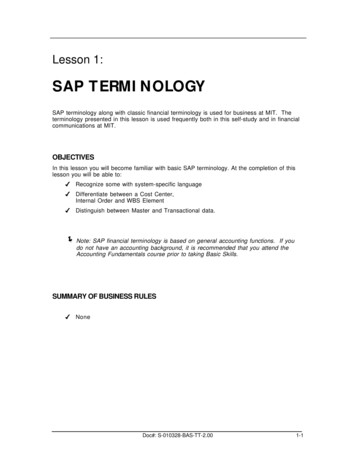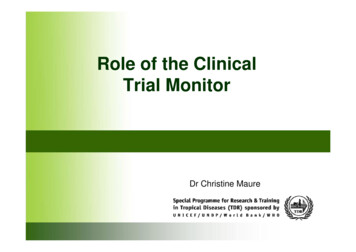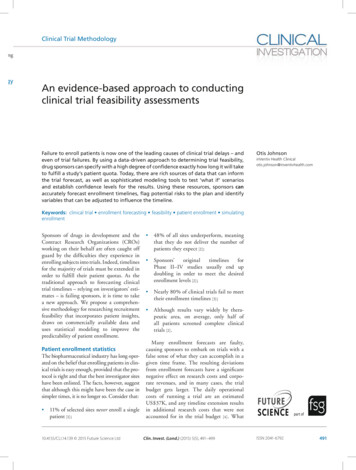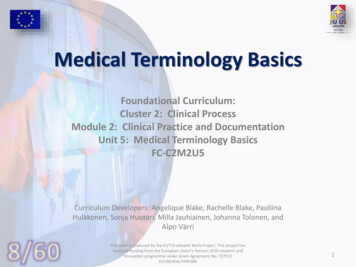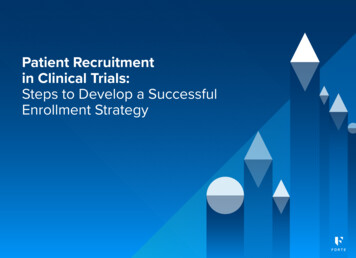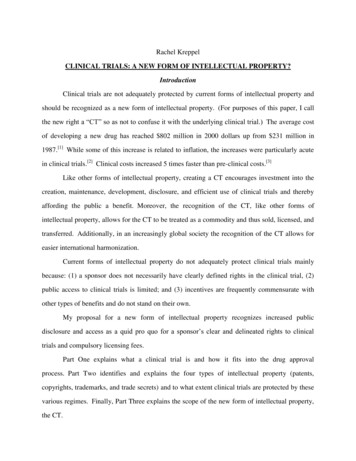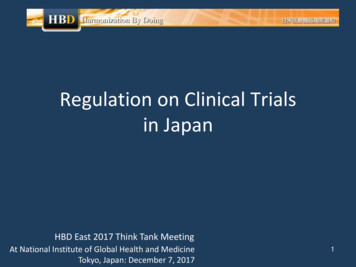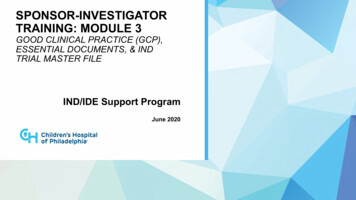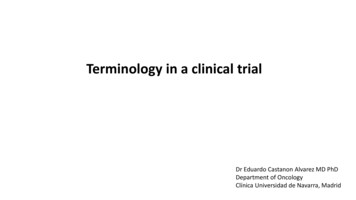
Transcription
Terminology in a clinical trialDr Eduardo Castanon Alvarez MD PhDDepartment of OncologyClínica Universidad de Navarra, Madrid
INDEX1. Clinical trial definition2. Types of clinical trials3. Objectives4. Endpoints5. Adverse events/Serious adverse events/Adverse events of special interest6. Questions and answers
INDEX1. Clinical trial definition2. Types of clinical trials3. Objectives4. Endpoints5. Adverse events/Serious adverse events/Adverse events of special interest6. Questions and answers
Clinical trials definitionClinicaltrials.gov definition“A clinical trial is a research study to answer specific questions about vaccines or new therapies or new ways of using known treatments”
INDEX1. Clinical trial definition2. Types of clinical trials3. Objectives4. Endpoints5. Adverse events/Serious adverse events/Adverse events of special interest6. Questions and answers
Type of clinical trialsTypes and goals in 2000Phase IPhase IIPhase IIIGoalMTDActivityComparison nseSurvivalN rful
Type of clinical trialsTypes and goals in 2019Phase I/Phase IIPhase IIIGoalMTD/ActivityComparison ponseSurvivalN sample100-1000200-2000RegistrationRealPowerful
Type of clinical trialsBASKETUMBRELLA
Type of clinical trialsAdaptive trialsBhatt, Nejm, 2016
INDEX1. Clinical trial definition2. Types of clinical trials3. Objectives4. Endpoints5. Adverse events/Serious adverse events/Adverse events of special interest6. Questions and answers
OBJECTIVES Outlines the research question related to the aim of the study Concrete Clearly specified Examples:ToxicityResponseSurvival
OBJECTIVESPrimary objective Main objective Statistical design depends on itSample sizePowerAlpha error There might be 2 primary objetives, but remember to split alpha riskSecondary objective Important Do not affect design but Designs affects it (sample size, power )
INDEX1. Clinical trial definition2. Types of clinical trials3. Objectives4. Endpoints5. Adverse events/Serious adverse events/Adverse events of special interest6. Questions and answers
ENDPOINTSQuantitative measurement or data point needed to meet the objectivesTypes:BinaryOrdinalContinousEvent timeCategoricalTypeExampleExample valueBinaryPost op complicationsYes-NoOrdinalTumor responseCR, PR, SD, PDContinousQOL score0-100Event timeTime to deathMonths from treatmentstart to deathCategoricalToxicitiesCommon toxicities (nograde)
ENDPOINTSClinical endpointRepresent direct benefitsurvivaldecrease painabscense of diseaseSurrogate endpointDo not represent direct benefitCorrelates with clinical benefitFeatures Valid Highly correlated with outcome Yield same statistical inferenceas the definitive endpointTumor response –OSPFS—OSpCR—OS
ENDPOINTSDefinitionExample 1Example 2ObjectiveTo compare efficacy (ORR)of drug A vs drug BTo compare efficacy (OS)of drug A vs drug BEndpointBest overall reponsedefined by CR, PR, SD orPD by RECIST 1.1Survival time for eachpatient, defined as thedifference in time fromthe start of treatment todeath or last contactStatisticResponse frequencydefined as the proportionof all treated patients whohave complete or partialresponseOverall survivaldistributions estimatedusing Kaplan–Meiermethod, and mediansurvival time for eachtreatment group; hazardratio estimated as asummary of treatmenteffect on risk of death
ENDPOINTSPatient centered endpoints1. OS: the time from randomization or start of treatment to death due to any cause, including deathfrom the trial disease or unrelated conditions.Affected by other treatments beyond the trialAffected by adverse eventsBE CAREFULCensored survival time: the time from the start of treatment to the date of lastcontact with patients who are alive.Competing risks: if follow up time is very long patients may die from other causes2. ToxicityDLT: Dose limiting toxicity
ENDPOINTSdosetime
ENDPOINTSPatient centered endpoints3. Health related quality of lifeHRQOL is the effect of cancer and treatment on the wellbeing of an individual patient
ENDPOINTSTumor centered endpoints1. PFS: the time from start of treatment or randomization until disease progression or death.Not affected by treatment beyond the trialSometimes it is a surrogate for OSBE CAREFULTiming for tumor analysisReal time of progression: unknown, but it is a valid surrogate (intervalcensored data)2. Time to progression: the time from start of treatment or randomization until disease progressionDeaths are not considered as eventDeaths are censored3. DFS: is defined as the duration between treatment start and relapse of disease or death from anycause.After surgeryMay be a good surrogate (long follow up)
ENDPOINTSTumor centered endpoints4. Objective response rateProportion of patients who have tumor size reduction of a predefined amount for aminimum time periodCR PR5. Disease control rateProportion of patients who have tumor size reduction or stable disease of a predefinedamount for a minimum time periodCR PR SD6. Duration of responseTime from initial tumor response (complete or partial response) to tumor progression andoften is reported with objective response rate.
INDEX1. Clinical trial definition2. Types of clinical trials3. Objectives4. Endpoints5. Adverse events/Serious adverse events/Adverse events of special interest6. Questions and answers
AEs/SAEs/AESIsAdverse event:Any unfavorable and unintended sign (such as laboratory finding), symptom, or diseasethat occurs while a patient is enrolled in a clinical trial.Maybe related or not to IPMaybe relevant or not regardless of relation to IPGrading CTCAE
AEs/SAEs/AESIsSerious adverse event: (FDA definition)Any AE that results in: death, illness requiring hospitalization, events deemed life-threatening, persistent or significant disability/incapacity, a congenital anomaly/birth defect, or a medically important condition
AEs/SAEs/AESIsAdverse events of Special InterestAn adverse event of special interest (serious or non-serious) is:An event of scientific and medical concern specific to the sponsor’s product or programRequires:ongoing monitoringrapid communication by the investigator to the sponsor.Such an event might warrant further investigation in order to characterize and understanditMUST BE REPORTED in 24 hours since ithas been noticed
TruthHypothesisNo effectEffectNo effectCorrectError type IIEffectError type ICorrectError alpha Saying that a drug is useful when it is NOTErro beta Saying that a drug is NOT useful when it REALLY is
INDEX1. Clinical trial definition2. Types of clinical trials3. Objectives4. Endpoints5. Adverse events/Serious adverse events/Adverse events of special interest6. Questions and answers
Terminology in a clinical trial Dr Eduardo Castanon Alvarez MD PhD Department of Oncology Clínica Universidad de Navarra, Madrid. INDEX 1. Clinical trial definition 2. Types of clinical trials . "A clinical trial is a research study to answer specific questions about vaccines or new therapies or
